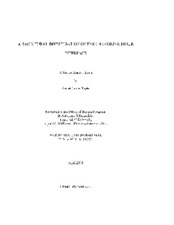| dc.creator | Hayes, Garret Lance | |
| dc.date.accessioned | 2013-02-22T20:40:38Z | |
| dc.date.available | 2013-02-22T20:40:38Z | |
| dc.date.created | 2003 | |
| dc.date.issued | 2013-02-22 | |
| dc.identifier.uri | https://hdl.handle.net/1969.1/ETD-TAMU-2003-Fellows-Thesis-H393 | |
| dc.description | Due to the character of the original source materials and the nature of batch digitization, quality control issues may be present in this document. Please report any quality issues you encounter to digital@library.tamu.edu, referencing the URI of the item. | en |
| dc.description | Includes bibliographical references (leaves 89-94). | en |
| dc.description.abstract | Macrophage Inflammatory Protein (MIP)-1b is a dimeric protein of the CC chemokine subfamily. Interest in both the structure and function of MIP-1b has increased rapidly over the past several years, resulting primarily from the discovery that MIP-1b has the ability to block infection of white blood cells by HIV. This discovery has instigated further inquiry into exactly how the structure of MIP-1b correlates to its function and, likewise, to its anti-HIV capacity. Of particular interest to us is the contrast between the structure of MIP-1b and a similar dimeric protein from the CXC chemokine subfamily, Interleukin-8 (IL-8). A comparison of the monomeric forms of IL-8 and MIP-1b shows a striking similarity between the two proteins. By examining the monomeric subunits of these two proteins, one would expect that similarity in their quaternary structure would follow suit. However, it has been shown that dimers of MIP-1b and IL-8 differ greatly, with one interacting along the first b-strand and C-terminal helix (IL-8) and the other along the N-terminus (MIP-1b). Such contrasting quaternary structures for essentially identical monomeric subunits is quite rare. In order to learn more about the protein-protein interactions that lead to dimerization and to more fully understand the chemokine dimmer interface, we attempted to alter the sequence of MIP-1b such that it will dimerize in like fashion to IL-8. Previous rational mutations have been successful in producing folded monomers but led us to believe that a strategy involving random mutagenesis was required for formation of the alternate dimer. Randomization coupled with a phage l selection system was used to search for MIP-1b variants that dimerize like IL-8. This process has thus far produced several variants currently under investigation by NMR. Preliminary data suggests that these proteins may exhibit some type of folded, alternate structure. | en |
| dc.format.medium | electronic | en |
| dc.format.mimetype | application/pdf | |
| dc.language.iso | en_US | |
| dc.publisher | Texas A&M University | |
| dc.rights | This thesis was part of a retrospective digitization project authorized by the Texas A&M University Libraries in 2008. Copyright remains vested with the author(s). It is the user's responsibility to secure permission from the copyright holder(s) for re-use of the work beyond the provision of Fair Use. | en |
| dc.subject | biochemistry. | en |
| dc.subject | Major biochemistry. | en |
| dc.title | A structural investigation of the chemokine dimer interface | en |
| thesis.degree.department | biochemistry | en |
| thesis.degree.discipline | biochemistry | en |
| thesis.degree.name | Fellows Thesis | en |
| thesis.degree.level | Undergraduate | en |
| dc.type.genre | thesis | en |
| dc.type.material | text | en |
| dc.format.digitalOrigin | reformatted digital | en |


